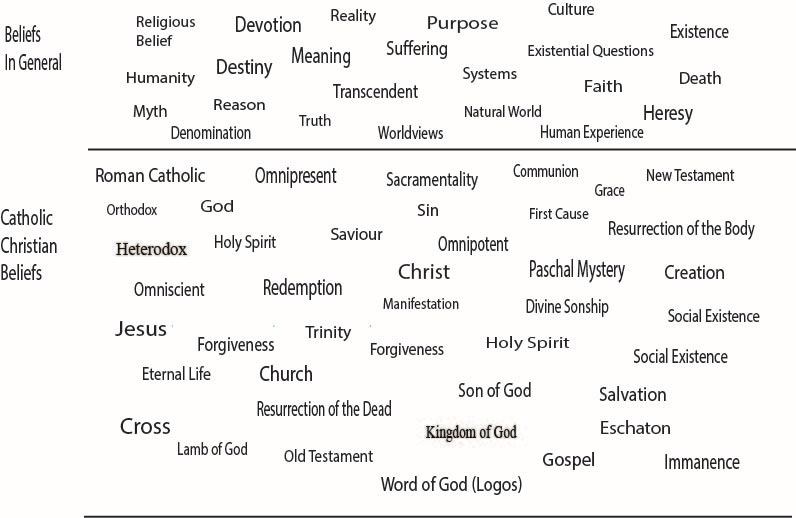Skills To be Developed
• explain the purposes of religion
• explain religious beliefs and their role in the search for meaning
• analyse connections between religious beliefs
• interpret, synthesise and apply primary and secondary source material.
• explain religious beliefs and their role in the search for meaning
• analyse connections between religious beliefs
• interpret, synthesise and apply primary and secondary source material.
Naming the Religious Tradition:
|
Sources of Beliefs in the Roman Catholic TraditionThe Roman Catholic Tradition has a shorthand way of explaining the source of its understanding about faith in Jesus Christ. It uses two words: Scripture and Tradition.
By the word Scripture, the Roman Catholics mean the Roman Catholic Bible in its two testaments with the canon (list) approved for use by the Church. By Tradition, Roman Catholics mean all the other aspects of religious traditions, including rituals and official prayer texts and symbolic gestures, ethics and moral codes, symbols, sacred stories, the social structure of the Church, the character of sacred spaces and places, sacred time and Catholic religious paraphernalia. For Roman Catholics these aspects are the essential sources of Christian belief and faith and the experience of all created reality is interpreted in the light of faith. The Magisterium or official teaching authority of the Roman Catholic Church is the final arbiter of the faith and the documents that contain that revealed truth. Magisterium consists of the pope and bishops in communion with the Bishop of Rome. Students must be able to use these sources of Roman Catholic faith to demonstrate the interconnected nature of the belief system. Primary source material may be drawn directly from documents approved by the Magisterium, official teaching of the Catholic Church. Quotations must be integrated into the text as examples or indicators of the key point being made by the writer. Secondary source material consists of commentaries on the primary ideas of Roman catholic faith. Both primary and secondary sources must be correctly acknowledged in the text using common protocols. Keywords Chart |
Connections between Beliefs
There is a danger that the beliefs of religious traditions when studied independently in categories can give the impression that they are somehow separate pieces of data. The beliefs of any religious system of meaning and belief are integrated. They provide a cohesive and overarching narrative for the adherents of the tradition.
The challenge is to be able to demonstrate the integrated nature of Roman Catholic faith. The following chart is shows some relationships in tabular form.
The challenge is to be able to demonstrate the integrated nature of Roman Catholic faith. The following chart is shows some relationships in tabular form.
Your browser does not support viewing this document. Click here to download the document.
|
The dogmatic faith claims of any religious system of meaning and belief are integrated. They provide a cohesive and overarching narrative for the adherents of the tradition. The analysis of any significant category of belief of the tradition will afford evidence of the integrated nature of the faith system. Beliefs in one category rely on or are enhanced by beliefs in other categories. So the religious tradition's understanding of Ultimate Reality will colour and inform beliefs in all other categories. The doctrines as a whole form the rainbow of faith in which believers seek to understand the universe and its relationships as an integrated whole.
|
An example from the Roman Catholic Tradition shows this integration.
Roman Catholic beliefs in ultimate reality can be found in the creeds (Nicene and Apostles). God is understood as a tri-unity or trinity of three persons, a Father, the Son and the Holy Spirit. In this understanding the divine persons are a union of love, calling all creation into an evolving fruitfulness. Trinitarian love spills over to the whole of created reality. Creation is a sacrament of the creator. Creator God has placed humans at the service of the environment as stewards and co-creators in love. The human person is made by the creator in the image and likeness of God (Genesis 1:26-27) and is called to know, love and serve God. The values of the kingdom seen in the beatitudes of Jesus express the love of God that values humility, faithfulness and holds a special interest in the poor. This is linked to the reality of suffering that can be both spiritual and physical. Christians are able to participate in their own redemption by uniting their suffering with that of Christ in the mystery of his death and resurrection (Paschal Mystery). For Christians, death is not the final word and there is a final judgement before the master of creation on the last day that determines human destiny in a life that is eternal. |

